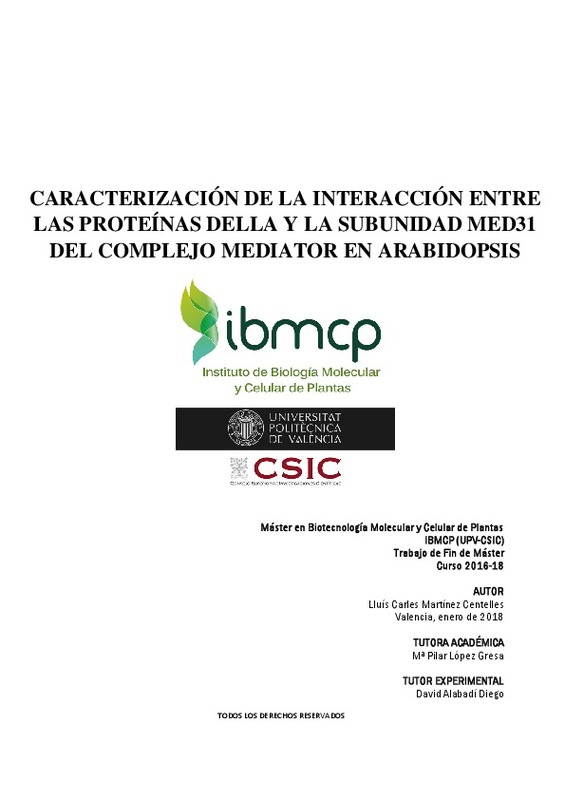|
Resumen:
|
[EN]
In our laboratory we are investigating about the molecular mechanisms by which DELLA proteins
regulate gene expression in plants. DELLA are the negative regulators of the signaling pathway for
gibberellins and their ...[+]
[EN]
In our laboratory we are investigating about the molecular mechanisms by which DELLA proteins
regulate gene expression in plants. DELLA are the negative regulators of the signaling pathway for
gibberellins and their levels are negatively regulated by this hormone. The results obtained in the
laboratory, together with those of others, have shown that an important part of this regulation occurs
through the physical interaction of DELLA proteins with transcription factors, in some cases inactivating
them, while in others the interaction promotes their activity. The latest results of the laboratory suggest
that DELLA can act through other mechanisms to regulate gene expression, in particular, physical
interactions have been found with several proteins that directly regulate RNA Pol II activity.
One of these proteins is MED31. MED31 is part of the Mediator complex, a multiprotein complex
conserved from yeast to humans which assists RNA Pol II practically all the stages of gene transcription,
so it’s considered as a transcriptional activator. All in all, these preliminary results suggest that DELLA
could regulate the transcription of certain genes modulating the activity of the Mediator complex and
therefore of the RNA Pol II through the interaction with subunit MED31. Previous work in the laboratory
has shown that a hypomorphic mutation med31 has very important consequences in plant development,
pointing out to a relevant function. In this TFM context, we will try to (i) obtain new med31 alleles of
Arabidopsis by amiRNA; (ii) characterize the interaction between DELLA and MED31 proteins in Nicotiana
benthamiana and Arabidopsis plants and (iii) evaluate the relevance of the interaction through
transcriptomic and physiological analysis.
[-]
[ES] En el laboratorio se está investigando los mecanismos moleculares por los que las proteínas DELLA regulan la expresión génica en plantas. Las DELLA son los reguladores negativos de la vía de señalización por giberelinas ...[+]
[ES] En el laboratorio se está investigando los mecanismos moleculares por los que las proteínas DELLA regulan la expresión génica en plantas. Las DELLA son los reguladores negativos de la vía de señalización por giberelinas y sus niveles son regulados negativamente por esta hormona. Los resultados obtenidos en el laboratorio, junto a los de otros, han mostrado que una parte importante de esta regulación ocurre mediante la interacción física de las proteínas DELLA con factores de transcripción, en unos casos los inactiva, mientras que en otros la interacción promueve su actividad. Los últimos resultados del laboratorio apuntan a que las DELLA pueden actuar mediante otros mecanismos para regular la expresión génica, en particular, se ha encontrado interacción física con varias proteínas que regulan directamente la actividad de la RNA Pol II.
Una de estas proteínas es MED31. MED31 forma parte del complejo Mediator, que es un complejo multiproteico conservado de levaduras a humanos y que asiste a la RNA Pol II en prácticamente todas las etapas de la transcripción de un gen y que es considerado por tanto como un activador transcripcional. Por tanto, estos resultados preliminares apuntan a que las DELLA podrían regular la transcripción de ciertos genes modulando la actividad del complejo Mediator y por tanto de la RNA Pol II a través de la interacción con la subunidad MED31. Trabajo previo en el laboratorio ha mostrado que una mutación hipomorfa med31 tiene consecuencias muy importantes en el desarrollo de la planta, apuntando a que tiene una función relevante. En el contexto de este TFM vamos a tratar de (i) obtener nuevos alelos med31 de Arabidopsis por RNAi y amiR; (ii) caracterizar la interacción entre las proteínas DELLA y MED31 en plantas de Nicotiana benthamiana y de Arabidosis, y (iii) evaluar la relevancia de la interacción mediante análisis transcriptómicos y fisiológicos.
[-]
|







